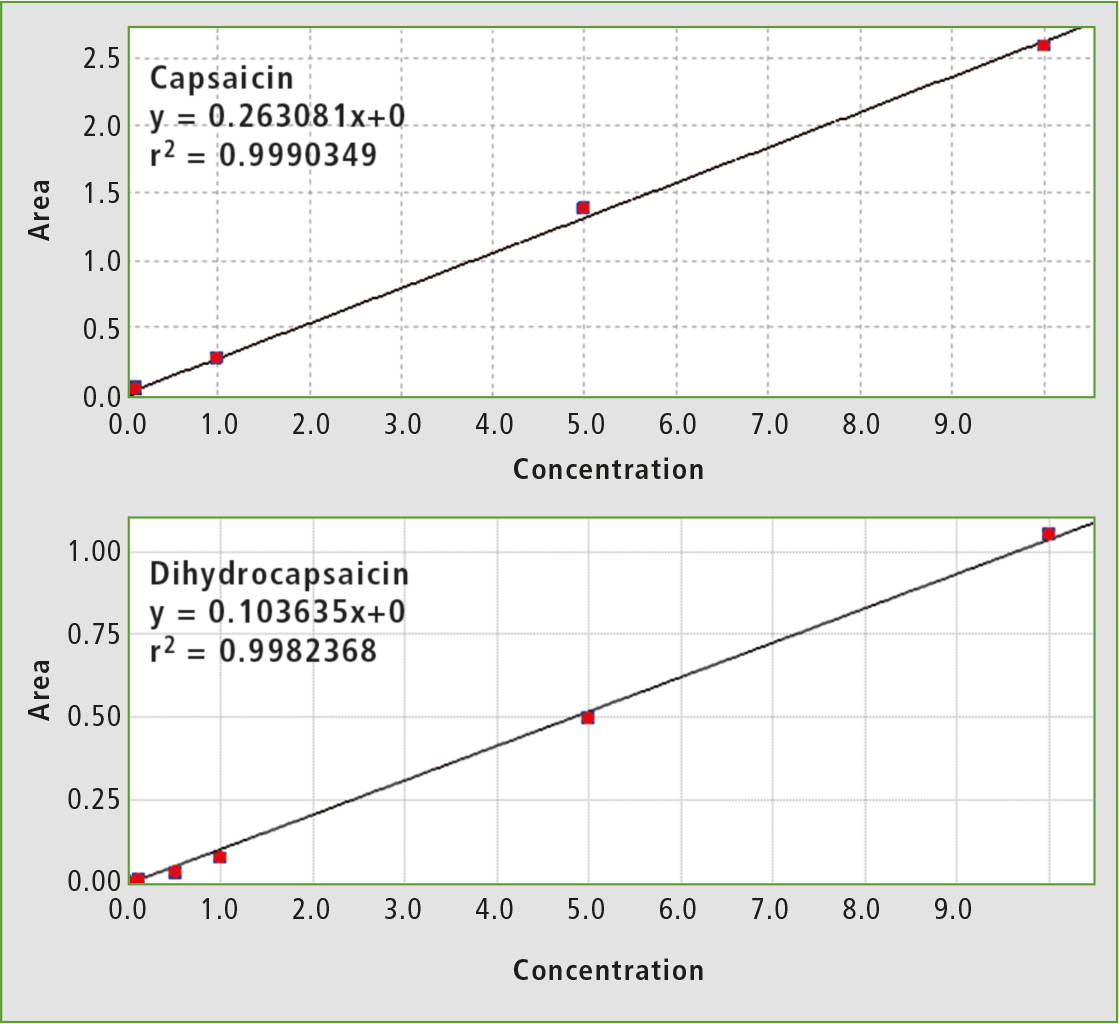New anti-doping method for equestrian sports
Application of LCMS-8050 to quantify capsaicin and dihydrocapsaicin in horse serum
 Members of research team
Members of research team
The Institute of Toxicological Research at Wroclaw Medical University in Poland routinely analyzes biological samples and evidence material on commission of the police, the prosecutor’s office and the courts. Research encompasses both targeted and screening analyses including pharmaceuticals, drugs of abuse, new psychoactive substances, alcohols, volatile substances, anabolics and many others. The Institute is also interested in developing new methods of analysis for specific needs of customers from scientific fields, industries, veterinary medicine and medicine.
The Equine Internal Medicine Unit, part of the Department of Internal Disease with Clinic for Horses, Dogs and Cats, is a scientific group focused on clinical work, teaching and research in the field of internal diseases of horses. Main current research of group members includes asthma, metabolic and endocrine diseases and kidney failure of horses. Application possibilities of innovative biomarkers in diagnostics of internal diseases of horses are also investigated.
Strong analgesic properties of Capsicum peppers
Capsaicin and dihydrocapsaicin, alkaloids from Capsicum peppers, are used in medicine and veterinary medicine due to their strong analgesic properties. Local analgesic effect is related to defunctionalization of nerve endings. In the case of horses, both capsaicin and dihydrocapsaicin are used as analgesic and warming gels or ointment. They are widely used in treatment of lameness and limb localized pain. Due to strong analgesic properties and fast action, capsaicin has been placed on the Equine Prohibited Substances List created by the International Federation for Equestrian Sports.
Y. You et al. [1] in 2013 proved the possibility of using UHPLC-MS-MS for the detection of capsaicin in plasma samples. The method described is fast, selective, sensitive, reproducible, reliable and fully validated.
The aim of this papers’ [2] research was to determine the time limit for the detection of capsaicin and dihydrocapsaicin after long-term use of gel containing capsaicin on horses. Of particular interest was to determine how soon after prolonged use of ointment or gel with capsaicin in pain treatment (following manufacturer application recommendations), horses would be able to take part in competition bearing in mind the anti-doping regulations applied in equestrian sports.
 Members of research team
Members of research team
Sample preparation
A serum sample (200 µL) was transferred into a 2 mL polypropylene tube. 20 µL of an internal standard solution (methanol solution of phenacetin, 100 ng/mL) was added. A liquid-liquid extraction using dichloromethane (1 mL) was carried out for five minutes. After shaking, samples were centrifuged at 10,000 rpm for five minutes. The organic phase was transferred into a clean 2 mL tube and evaporated to dryness under a stream of nitrogen at 40 °C. The extract was dissolved in 25 µL of methanol, transferred to an inert glass insert and analyzed using UHPLC-QqQ-MS/MS.
UHPLC-MS/MS analysis
Analysis was performed using a Nexera X2 UHPLC system coupled with an LCMS-8050 triple quadrupole mass spectrometer with ESI in positive ionization. The analytes were then quantified by multiple reaction monitoring (MRM). MRM transitions were m/z 180.30 → 110.05; 180.30 → 93.10; 180.30 → 65.05 for phenacetin, m/z 306.10 → 137.05; 306.10 → 94.10; 306.10 → 122.05 for capsaicin and m/z 308.40 → 137.10; 308.40 → 94.10; 308.40 → 122.10 for dihydrocapsaicin. The analytes were separated using a C18 1.7 µm, 2.1 x 50 mm column at 40 °C. A combination of 10 mM ammonium formate / 0.1 % formic acid in water (A) and 0.1 % formic acid in acetonitrile (B) was used as mobile phase. Injection volume was 1 µL.
Results
The limits of quantification of the analysis were 0.5 pg/mL for capsaicin and 1 pg/mL for dihydrocapsaicin. Figure 1 shows the chromatogram of pretreated horse serum containing capsaicin (1 pg/mL) and dihydrocapsaicin (1 pg/mL).
 Figure 1: MRM of capsaicin and dihydrocapsaicin in blank equine serum at concentration of 1 pg/mL
Figure 1: MRM of capsaicin and dihydrocapsaicin in blank equine serum at concentration of 1 pg/mL
Y. You et al. research from 2013 on capsaicin and dihydrocapsaicin concentrations in equine plasma [1] has proven that after application of paste containing 0.025 % of capsaicin, both capsaicin and dihydrocapsaicin occurred in plasma, with a concentration of nearly 242 and 155 pg/mL respectively in two hours, but after 24 hours the concentrations declined to nearly 5 and 3 pg/mL, respectively. By reaching LOQ at 0,5 pg/mL and 1 pg/mL level, the method presented therefore enables effective detection of capsaicin even after 24 hours following application of gels containing this compound.
Very good linearity was achieved in the concentration range from 0.5 to 1,000 pg/mL (capsaicin) and 1 to 1,000 pg/mL (dihydrocapsaicin). Calibration curves and linear regression coefficients are shown in figure 2.
 Figure 2: Calibration curves of capsaicin (above) and dihydrocapsaicin (below)
Figure 2: Calibration curves of capsaicin (above) and dihydrocapsaicin (below)
Real samples analysis
The method described was successfully applied for the detection of capsaicin and dihydrocapsaicin in horse serum following long-term local administration [2].
Conclusions
The undoubted advantages of the method presented are its simplicity, high sensitivity and the fast sample preparation procedure. The possibility of detection of capsaicin and its metabolite in concentrations from 0,5 pg/mL respectively 1 pg/mL enables the effective fight against this kind of doping in equestrian sports. Capsaicin also has more applications, so after small modifications, the method described can be used for determination of capsaicin and dihydrocapsaicin in chili peppers, self-defense weapons or biological samples collected from individuals exposed to these substances.
Authors
Paweł Szpot, Marcin Zawadzki, Marta Siczek, Agnieszka Zak, Natalia Siwinska, Malwina Słowikowska, Artur Niedzwiedz
The Equine Internal Medicine Unit, part of the Department of Internal Disease with Clinic for Horses, Dogs and Cats, Wrocław, Poland
Literature
1. Y. You, C. E. Uboh, L. R. Soma, F. Guan, D. Taylor, X. Li, Y. Liu, J. Chen: Validated UHPLC–MS-MS Method for Rapid Analysis of Capsaicin and Dihydrocapsaicin in Equine Plasma for Doping Control, Journal of Analytical Toxicology (2013) 37(2) 122-132. DOI 10.1093/jat/bks098.
2. A. Zak, N. Siwinska, M. Slowikowska, H. Borowicz, P. Szpot, M. Zawadzki and A. Niedzwiedz: The detection of capsaicin and dihydrocapsaicin in horse serum following long-term local administration BMC Veterinary Research (2018) 14:193. DOI 10.1186/s12917-018-1518-9